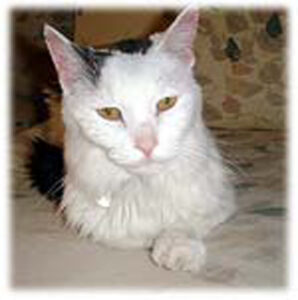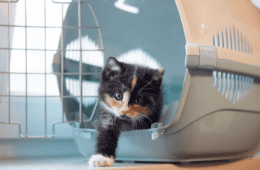Love, loyalty, and the bond between a pet and its owner are universal experiences. But what happens when the playful and affectionate cat you've known for years begins to change? Max, a 15-year-old Manx cat, transformed from a lively companion into a withdrawn and confused family member. This story "Love To The Max" unveils the mysteries of cognitive dysfunction, not commonly known in cats, something akin to human Alzheimer's.
In the journey with Max, we will explore the symptoms, the despair of a loving owner, and a glimmer of hope that emerges from a ground-breaking experiment. Is there a chance to save Max? Could this discovery change the lives of other cats and their owners? Join us as we unravel the emotional and scientific adventure that began in a small house in Arizona, where a senior cat named Max looked back with love.

A Connection Transformed: The Beginning of Change
"I've had Max since he was six weeks old," says Elizabeth Jones, a computer graphics specialist in Mesa, Arizona. She chose the white with gray Manx kitty because he was so playful and affectionate.
Over the past 15 years, Max never met a stranger. "He'd always come right up to get in your lap, make himself comfortable, and just rub himself on your face," she says.
However, a subtle but troubling transformation began to take hold in the past two years. The lively Max, who would once race towards his bowl at the mere sound of kibble, started losing interest in his favorite treats.
Elizabeth sensed a shift, a foreboding change in the behavior and personality of her cherished companion. Was something wrong with Max? The once joyful and energetic connection was beginning to wane, and uncertainty loomed on the horizon.
The Ordeal: Onset Of Cognitive Dysfunction In Cats
Max's transformation was unsettling. He began to lose weight and became reluctant to interact. His demand for marathon lap-snuggling sessions ceased, and he no longer showed interest in head-bumping visitors.
The gregarious friend Elizabeth had always known began to hide. Then, as Elizabeth graduated from university and landed her dream job last March, things took a dramatic turn for the worse.
Unfamiliar Behavior: Struggling to Understand
"He'd poop on my bed, or pee right in my spot where I sit on the couch," Elizabeth describes, worry evident in her voice. Max's eyes took on a glazed look, and his anxious behavior was deeply concerning.
He either hid or wailed for attention, even climbing into bed in the middle of the night to cry and wake Elizabeth, leaving a mess. "I was at the end of my rope," she confesses. "I had to deal with this ailing kitty that's always been so friendly and wonderful, and very loving."
Emotional Toll: Facing a Painful Decision
Elizabeth became more and more upset as Max's cognitive dysfunction worsened. "He had this look in his eyes that said: 'Who are you? where am I? I don't know what's going on! I'm upset, and I don't feel well,'" she says.
"If you see an animal suffer like that, I feel it's your responsibility not to prolong that." She desperately loved her cat and was torn by the thought of losing him, but knew she'd ultimately have to put Max to sleep.
Reflection: The Changing Nature of Companionship
Although cat lovers of today are privileged to enjoy longer-lived cats -- 15 to 20 years isn't uncommon -- we recognize aging cats may develop a health problem or disability.
Most cats will not outlive us. Is it selfish to want to prolong his life? Cost of care, concerns over his comfort, and guilt about making these choices can make the last weeks or months together even more difficult.

When is the Right Time to Say Goodbye?
There is no wrong answer. It doesn't matter what other folks think, or what they'd do. Every situation is different, and what applies to others may have no bearing on your situation.
Any choice you make that's based on love and concern for his welfare cannot be wrong.
Seeking Medical Insight: Cognitive Dysfunction In Cats
The suffering for both Max and his loving owner had been going on for five months when Elizabeth received a questionnaire from Max's veterinarian. Dr. Kelly Moffat of the Mesa Veterinary Hospital requested information for a study about senior cat patients.
Participation in the study included complete blood work and physical and neurological exams. Elizabeth jumped at the chance that something would be found that could help return Max to normal or at least improve his quality of life.
Diagnosing the Problem
The tests offered both good news and bad. For his age, Max was quite healthy. They couldn't find anything to treat. Dr. Moffat said there were no physical problems to account for his distress and behavior problems. Elizabeth's hopes fell when the doctor explained that at a certain stage of the game, some cats deteriorate on a cognitive level.
The symptoms Max exhibited were typical of feline senility. This condition has more frequently been described in dogs and is pretty new to feline medicine.
SIGN UP FOR THECATSITE'S EMAIL UPDATES >
Exploring Cognitive Dysfunction: A New Frontier
"There's now a pretty well-understood syndrome referred to as Canine Cognitive Dysfunction which basically represents a loss of memory and learning or a reduction in learning memory," says Dr. Benjamin Hart, a veterinary behaviorist at the University of California, Davis.
He adds that dogs, similarly to people suffering from Alzheimer's disease, develop a beta-amyloid pathology in the brain. This is a starch-like protein that becomes waxy once deposited in the tissues.
Max's veterinarian was conducting one of the first scientific surveys of cats suffering from cognitive dysfunction. "I started the study two years ago, and have since looked at 155 cats aged 11 to 21 years old," says Dr. Moffat.
Understanding Senility in Cats: The Research Perspective
"You're more likely to see it in 15-year-old and older cats," says Gary Landsberg, DVM, a behaviorist in Thornhill, Ontario. He authored one of the first research papers on cats that concluded, in part, that as many as 80 percent of cats he sees that are over the age of 16 show signs of senility.
"Some of the brain changes in [these cats] are similar to those seen in the early stages of human Alzheimer's," he says. Like the affected humans, cats with cognitive dysfunction also have deposits of amyloid material in the brain.
What if there is hope?
There currently is no medical treatment for the feline disease. Most cat owners have little choice but to end their pet's suffering by euthanization.
But there is hope. Elizabeth learned that the drug selegiline (brand name Anipryl) is FDA-approved to treat cognitive dysfunction in dogs. It has shown incredible results in a certain percentage of canine patients. She agreed to try an experimental treatment of Anipryl on Max.
This "off-label" use is legal as long as owners are informed, and Elizabeth was willing to try anything. She knew that Anipryl was Max's last chance.
The cat received half a tablet every morning. Elizabeth was amazed to notice a change within only a couple of days. "It was pretty dramatic!"
Max seemed to regain his composure overnight. His appetite returned, and he began to beg for food just like in old times. "Now he knows where he is, he recognizes me, he knows what's going on," says Elizabeth.
She is not only thrilled with Max's response, and relieved that he once again enjoys his life and is a full partner in their family; Elizabeth also cherishes the thought that Max's participation in the study will help other cats. That is, indeed, a fitting legacy to their years together.
Thoughts of putting Max to sleep have been put on permanent hold, ever since the glazed look in his golden eyes lifted to reveal what was always there, under the confusion:
Max looking back with love.
Pet Senility Symptoms
"In the past, these symptoms would have been brushed off as a normal part of aging," says Susan Little, DVM, a feline specialist in Ottawa, Canada. "It actually should be recognized as a specific health issue of a geriatric cat," says Dr. Little.
Affected dogs and cats typically seem to forget how to do normal activities. For example, they are unable to find the litter box or ask for a bathroom break, or they simply sit in the middle of the room and cry. Signs of cognitive dysfunction can be vague and confusing, and mimic other disease conditions. Look for:
- Disorientation: wanders aimlessly, acts lost and confused, may not recognize family members or other familiar people or places, gets "stuck" in corners, or is lost in the house.
- Interaction changes: no longer greets family members, dislikes or avoids petting, not as interested in getting attention, interaction changes with other pets.
- Sleep changes: is awake and active at night, sleep cycles are disrupted or reversed Housetraining is forgotten.
- Anxiety or compulsive behaviors: tremors, yowling and crying, repetitive pacing, floor or object licking.
Delaying the Inevitable?
The old saying, "Use it or lose it!" applies equally to pet brains. Studies of cognitive function in dogs proved that problem-solving activities kept them sharp, connected to the world around them, and even extended their lifespan.
Researchers also agree that mental stimulation drastically improves the cognitive function of aging cats. Keep your cat both physically active and mentally engaged throughout her life to keep her brain young and potentially prevent or slow the progression of aging changes.
Here are some things you can do to keep your aging cat both physically and mentally fit:
- Offer brain-stimulating viewing entertainment such as bird feeders outside windows.
- Teach your cat to walk on a leash.
- Bribe Garfield-type food-motivated cats with tasty treats to learn tricks; for instance, call "Fluffy come!" then turn on the can opener, and when the cat runs to you, reward them with a treat.
- Offer puzzle toys that reward the cat's interest by dispensing treats. This can mimic feline hunting behaviors and keep the cat entertained and mentally sharp.
Last Words: A Journey of Discovery and Love
The relationship between Elizabeth and Max is more than just a story about a cat and its owner; it's a testament to the unwavering bond between a pet and a human and a compelling narrative of hope in the face of adversity.
The discovery of Max's condition opened up a new chapter in feline medicine and offered a glimpse into a subject that remains relatively unexplored. As we grapple with the understanding of cognitive dysfunction in cats, Max's story symbolizes the importance of vigilance, love, and perseverance.
His successful response to treatment not only gave him a renewed chance at life but potentially paves the way for other cats suffering from similar ailments. The experimental treatment that saved Max is a beacon of hope for countless other pets and their families.
It may still be a long way from a cure, but it is undoubtedly a significant step in the right direction.
For those faced with the painful decisions that accompany a pet's aging and illness, Max's story offers comfort and inspiration. It tells us that even in the darkest times, there might be a solution around the corner and that no matter what, the love we share with our pets will always endure.
Whether it's exploring new medical frontiers or cherishing the simple joy of a pet looking back with love, the story of Max and Elizabeth is a heartfelt lesson in compassion, resilience, and the timeless bond between humans and their animal companions.
SIGN UP FOR THECATSITE'S EMAIL UPDATES >
Related Reading:
Why You Should Not Surrender Senior Cats To Shelters
Written Contributions by Amy Shojai
Amy D. Shojai is a nationally known pet care specialist, and author of more than a dozen pet books, including the forthcoming "Complete Care for Your Aging Cat" and "Complete Care for Your Aging Dog." She can be reached through her website www.shojai.com
Comments? Leave them using the comment section below. Questions? Please use the cat forums for those!
Note: We may get commissions for purchases made through links on this page.




One comment on “Understanding And Treating Cognitive Dysfunction In Cats”